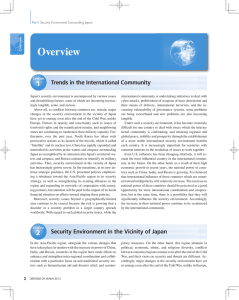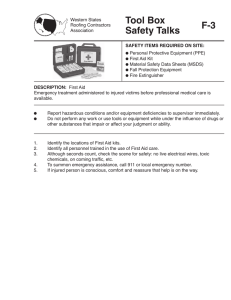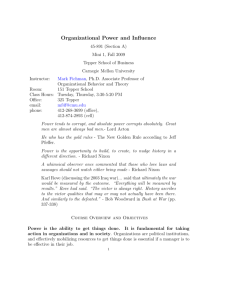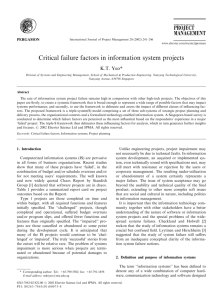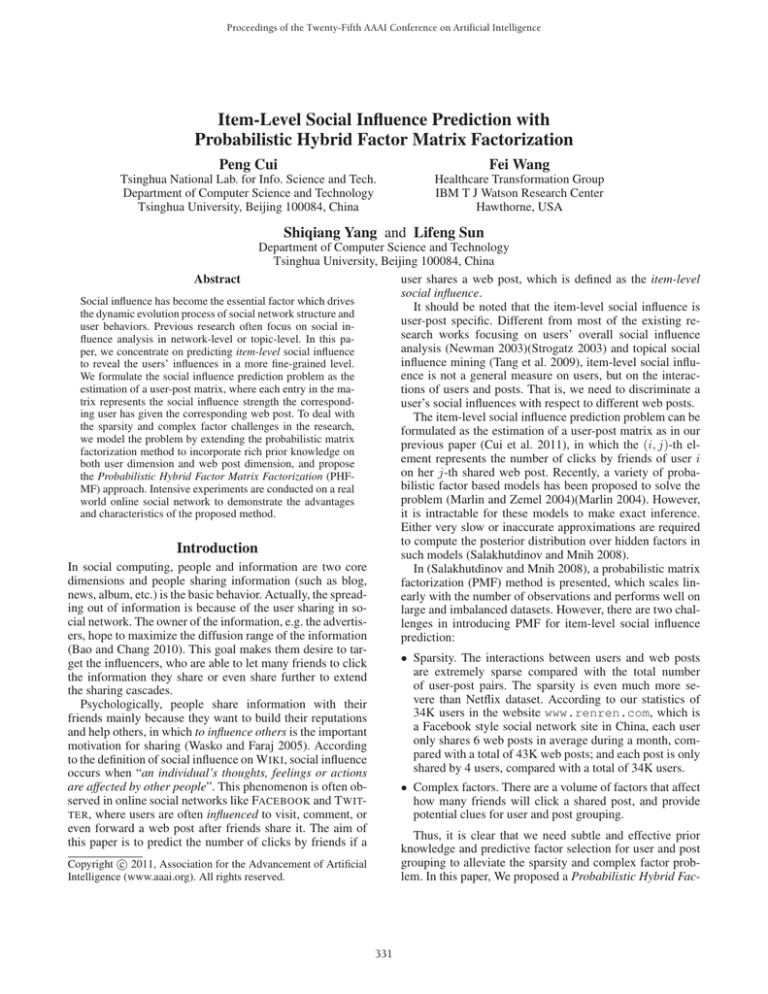
Proceedings of the Twenty-Fifth AAAI Conference on Artificial Intelligence
Item-Level Social Influence Prediction with
Probabilistic Hybrid Factor Matrix Factorization
Peng Cui
Fei Wang
Tsinghua National Lab. for Info. Science and Tech.
Department of Computer Science and Technology
Tsinghua University, Beijing 100084, China
Healthcare Transformation Group
IBM T J Watson Research Center
Hawthorne, USA
Shiqiang Yang and Lifeng Sun
Department of Computer Science and Technology
Tsinghua University, Beijing 100084, China
user shares a web post, which is defined as the item-level
Abstract
social influence.
Social influence has become the essential factor which drives
It should be noted that the item-level social influence is
the dynamic evolution process of social network structure and
user-post specific. Different from most of the existing reuser behaviors. Previous research often focus on social insearch works focusing on users’ overall social influence
fluence analysis in network-level or topic-level. In this paanalysis (Newman 2003)(Strogatz 2003) and topical social
per, we concentrate on predicting item-level social influence
influence mining (Tang et al. 2009), item-level social influto reveal the users’ influences in a more fine-grained level.
ence is not a general measure on users, but on the interacWe formulate the social influence prediction problem as the
estimation of a user-post matrix, where each entry in the mations of users and posts. That is, we need to discriminate a
trix represents the social influence strength the corresponduser’s social influences with respect to different web posts.
ing user has given the corresponding web post. To deal with
The item-level social influence prediction problem can be
the sparsity and complex factor challenges in the research,
formulated as the estimation of a user-post matrix as in our
we model the problem by extending the probabilistic matrix
previous paper (Cui et al. 2011), in which the (i, j)-th elfactorization method to incorporate rich prior knowledge on
ement
represents the number of clicks by friends of user i
both user dimension and web post dimension, and propose
on her j-th shared web post. Recently, a variety of probathe Probabilistic Hybrid Factor Matrix Factorization (PHFbilistic factor based models has been proposed to solve the
MF) approach. Intensive experiments are conducted on a real
problem (Marlin and Zemel 2004)(Marlin 2004). However,
world online social network to demonstrate the advantages
it is intractable for these models to make exact inference.
and characteristics of the proposed method.
Either very slow or inaccurate approximations are required
to compute the posterior distribution over hidden factors in
Introduction
such models (Salakhutdinov and Mnih 2008).
In social computing, people and information are two core
In (Salakhutdinov and Mnih 2008), a probabilistic matrix
dimensions and people sharing information (such as blog,
factorization (PMF) method is presented, which scales linnews, album, etc.) is the basic behavior. Actually, the spreadearly with the number of observations and performs well on
ing out of information is because of the user sharing in solarge and imbalanced datasets. However, there are two chalcial network. The owner of the information, e.g. the advertislenges in introducing PMF for item-level social influence
ers, hope to maximize the diffusion range of the information
prediction:
(Bao and Chang 2010). This goal makes them desire to tar• Sparsity. The interactions between users and web posts
get the influencers, who are able to let many friends to click
are extremely sparse compared with the total number
the information they share or even share further to extend
of user-post pairs. The sparsity is even much more sethe sharing cascades.
vere than Netflix dataset. According to our statistics of
Psychologically, people share information with their
34K users in the website www.renren.com, which is
friends mainly because they want to build their reputations
a Facebook style social network site in China, each user
and help others, in which to influence others is the important
only shares 6 web posts in average during a month, commotivation for sharing (Wasko and Faraj 2005). According
pared with a total of 43K web posts; and each post is only
to the definition of social influence on W IKI, social influence
shared by 4 users, compared with a total of 34K users.
occurs when “an individual’s thoughts, feelings or actions
are affected by other people”. This phenomenon is often ob• Complex factors. There are a volume of factors that affect
served in online social networks like FACEBOOK and T WIThow many friends will click a shared post, and provide
TER , where users are often influenced to visit, comment, or
potential clues for user and post grouping.
even forward a web post after friends share it. The aim of
Thus, it is clear that we need subtle and effective prior
this paper is to predict the number of clicks by friends if a
knowledge and predictive factor selection for user and post
grouping to alleviate the sparsity and complex factor probc 2011, Association for the Advancement of Artificial
Copyright Intelligence (www.aaai.org). All rights reserved.
lem. In this paper, We proposed a Probabilistic Hybrid Fac-
331
tor Matrix Factorization (PHF-MF) algorithm for item-level
social influence modeling. In this model, we try to find out
the common hidden vector space for both the users and the
posts, where their multiplication can well approximate the
observed training user-post matrix. Meanwhile, in order to
alleviate the sparsity problem, we construct the priors on
users and posts by incorporating the user-specific factors and
post-specific factors, and apply gradient descent to solve the
PHF-MF problem.
It is worthwhile to highlight the key contributions of this
paper.
• We extend the Probabilistic Matrix Factorization model
by introducing constraints on two dimensions of the interaction matrix in PHF-MF, which make it feasible to
incorporate prior knowledge in a probabilistic matrix factorization framework.
• The proposed PHF-MF gives a probabilistic interpretation
of the previously proposed Hybrid Factor Non-Negative
Matrix Factorization (HF-NMF) in (Cui et al. 2011),
which makes the model more theoretically solid.
• We conducted intensive experiments on real social network datasets, and the results show that the PHF-MF can
achieve a better performance compared with other competitors.
With the above terminologies, we can formally define the
task of item-level social influence prediction. We denote the
user-post influence matrix as X̃ ∈ RM ×N , with its (i, j)-th
entry
fij if ui shared pj
X̃ij =
(1)
0
otherwise
If we use gi to denote the number of ui ’s friends (i.e. gi =
|N (ui )|, where |.| is the cardinality of a collection), then
fij ≤ gi .
To measure the influence strength of different users in the
same scale, we propose the following percentile influence
matrix
fij
if ui shared pj
gi
(2)
Xij =
0
otherwise
so that Xij ’s are normalized into the range of [0, 1].
The user-post influence matrix X̃ can be reconstructed by
X̃ = Diag(g) · X
(3)
where g = [g1 , g2 , · · · , gN ] ∈ RN , and Diag(g) is the
diagonal matrix with g on the diagonal line.
Our formulation of the item-level social influence prediction problem is quite different from existing works on
social network analysis. First, we measure the social influence in item-level, compared with the structure-level analysis (Newman 2003)(Strogatz 2003) and topic-level analysis
works (Tang et al. 2009). Second, the goal of the problem
is to predict the users’ social influence for unobserved data,
which is in contrast with the majority of existing works to
analyze the influence patterns from observed data (Anagnostopoulos, Kumar, and Mahdian 2008)(Bakshy, Karrer, and
Adamic 2009).
Problem Formulation
First, to make the paper self-contained, we formally define
the problem of item-level social influence prediction as (Cui
et al. 2011). Suppose we have M users with the i-th user
denoted as ui and N postings with the j-th post denoted as
pj . We use N (ui ) to denote the collection of ui ’s first-order
friends (i.e. the nodes that directly link to ui ). As mentioned
in the introduction, two key factors that need to be formulated in our model are:
• Item-level social influence: The strength of ui ’s influence on N (ui ) given the web post pj , denoted as fij , is
defined the number of ui ’s friends who clicked post pj .
We assume that the influence should be specific on each
user-post pairs: (1) different users have different influence
power to their friends; (2) different posts have different influence power (more intuitively, attraction) to users who
are interested in; and (3) users’ influences manifest differently for different posts. Therefore, only item-level social
influence can reveal the users’ real influence on friends,
and the strength of influence should definitely be userpost specific.
• Social influence prediction: The social influence prediction is to predict the unobserved social influences fˆij
based on the observed fij ’s and those predictive factors.
One issue that is worthy of emphasizing here is that the
user factors and post factors are essential for the predictive modeling. On one hand, the user-post interactions are
very sparse. We need to find effective factors to “group”
those users and posts to alleviate the sparsity problem. On
the other hand, the user and post-specific factors also provide some effective prior knowledge to complement the
inference from pure user-post interactions.
Probabilistic Matrix Factorization
We suppose that there exists a joint latent space for both
users and posts with common dimensionality k, such that
the user-post specific social influences are modeled as the inner product between user-post vector pairs in that space. Accordingly, the user ui is associated with an user vector Ui ∈
Rk , and the post pj is associated with a post vector Vj ∈ Rk .
We also define two matrices U = [U1 , U2 , · · · , UM ] ∈
Rk×M , V = [V1 , V2 , · · · , VN ] ∈ Rk×N . As the model
performance is evaluated by root mean square error (RMSE)
on the test set, we adopt a probabilistic linear model with
Gaussian observation noise as in (Salakhutdinov and Mnih
2008). Here we define the the conditional distribution over
the observed entries in X as
2
)=
P (X|U, V, σX
N
M 2
N (Xij |U
i Vj , σX )
Yij
(4)
i=1 j=1
where Yij is the indicator of user ui sharing web post pj .
We assume zero-mean spherical Gaussian priors on user
and post feature vectors:
2
)=
P (U|σU
M
i=1
332
2
N (Ui |0, σU
I)P (V|σV2 ) =
N
j=1
N (Vi |0, σV2 I)
Incorporating Post-Specific Factors
Then the log posterior distribution over the user and post
feature vectors is calculated by
From our investigations on www.renren.com, the so-
2
2
ln P (U, V|X, σX
, σU
, σV2 )
(5) cial influence is strongly correlated with the content of the
web posts. For example, the posts on popular topics attract
1
1 1 2
∝− 2
Yij (Xij −Ui Vj ) − 2
Ui Ui − 2
Vi Vi more clicks in average. We denote the post content matrix
2σX i,j
2σU i
2σV i
N ×d
, where d is the dimensionality of the posts,
as C ∈ R
which is constructed by implementing Latent Dirichlet Allocation (LDA) (Blei, Ng, and Jordan 2003) on the post corpus
to discover 100 topics. Then the content of each post is represented as the topic distributions over the 100 topics. Similar to latent semantic analysis (Hofmann 1999), we assume
there exists matrix G ∈ Rd×k which indicates topic group
identity, and the conditional distribution over C is defined as
Therefore to obtain the Maximum A Posteriori (MAP) estimation of U and V is equivalent to minimize
1 Y (X − UV )2 + 1 U2 + 1 V2 (6)
F
F
2
2
F
2σX
2σU
2σV2
where ||.||2F is the Frobenius Norm, and the is the
Hardamard Product.
Hybrid Factors
2
P (C|V, G, σC
)=
N
d
m=1
n=1
2
N (Cmn |Vm
(G )n , σC
) (11)
where (G )n is the n-th column of G .
As mentioned above, the severe sparsity of X makes it
very challenging to directly learn the latent spaces for users
and posts from only observed user-post interaction entries.
That’s the reason why we need to make full use of the userspecific and post-specific factors to compress the degrees of
freedom, so that the correlation within users and web posts
can be exploited to alleviate the sparsity problem.
Probabilistic Hybrid Factor MF
In this section, we will introduce a method, Probabilistic Hybrid Factor Matrix Factorization, to integrate all the
above factors and get an estimation of the latent user and
post matrices.
Incorporating User-Specific Factors
The Model
We selected two effective user-oriented predictive factors:
the percentage of active friends, and the average friend tie
strength, which are defined as follows.
• The percentage of active friends. The activeness of a
friend ur , denoted by act(ur ), is the number of posts she
visited during a given time period. Then the percentage of
active friends is calculated by
1
δ(act(ur ) ≥ τ ) (7)
uf1 (ui ) =
|N (ui )|
Given the observed matrices X, W, C, the posterior distribution over the user and web post latent features is given
by
P (X, W, C|U, V, Ω)P (U, V|Ω)
(12)
P (X, W, C)
∝ P (X|U, V, Ω)P (W|U, Ω)P (C|V, G, Ω)P (U|0, Ω)P (V|0, Ω)
P (U, V|X, W, C, Ω) =
2
2
2
2
where Ω = {σX
, σW
, σC
, σU
, σV2 } is the hyperparameter
set including the observed noise variance and prior variance
on user and feature vectors.
The log of the posterior distribution over the user and post
latent features is calculated by
ur ∈N (ui )
where τ is the time threshold for active user, and δ(.) is
the Delta function.
• The Average Friend Tie Strength. We define the tie
strength between a user ui and one of her friends ur as
the number of shared posts (by user ui ) friend ur visits,
which is denoted as tie(ui , ur ). Then, the average friend
tie strength is calculated by
tie(ui , ur )
1
.
(8)
uf2 (ui ) =
|N (ui )|
j Yij
ln(P (U, V|X, W, C, Ω))
1 1 2
2
Yij (Xij − U
(Wpq − U
∝− 2
i Vj ) −
p Uq )
2
2σX i,j
2σW
p,q
1 1 (Cmn − Vm
(G )n )2 − 2
Ui Ui
2
2σC m,n
2σU i
1 − 2
Vi Vi
2σV i
−
ur ∈N (ui )
We make use of these two factors to measure the similarity between ui and uj as
Wij = ρ1 |uf1 (ui )−uf1 (uj )|+ρ2 |uf2 (ui )−uf2 (uj )| (9)
Maximize the posterior distribution is equivalent to
minimize the sum-of-squared errors function with hybrid
quadratic regularization terms:
In our experiments, we set ρ1 = ρ2 = 0.5.
In this way, we can construct the user-user similarity matrix W ∈ RM ×M . We further assume that W can be approximated by the inner product of the latent user matrix.
Thus, the conditional distribution over the user-user similarity matrix is defined in a similar way as (4):
M M
2
2
)=
N (Wpq |U
(10)
P (W|U, σU
p U q , σW )
p=1
J = ||Y (X − U V)||2F + α||W − U U||2F
+β||C − VG ||2F + γ||U||2F + δ||V||2F .
where α =
q=1
333
2
2
2
2
σX
σX
σX
σX
,
β
=
,
γ
=
,
and
δ
=
.
2
2
2
σW
σC
σU
σV2
(13)
user information
user id (UID)
friend links
shared post id list
be formulated as a regression problem. Thus, we firstly
use the LR model to linearly combine the user factors and
post factors, and learn the regression coefficients of the
factors from the observed training data.
post information
post id
post content
visiting friend UID list
• Cox Proportional Hazards Regression (CoxPH): Different from LR, the user factors and post factors are combined in an exponential way, as is used in (Yang and
Counts 2010), which aims to predict the speed of diffusion of tweets in Twitter.
Table 1: Data set information.
Solution
• User Averaging Influence (AvgU): As users have different overall influences regardless of web posts, we can predict unobserved social influence by the average over observed ones, i.e.,
j fij
.
(14)
fi,. = j Yij
Although the objective function is not jointly convex with respect to U, V and G, it is convex with each of them with the
other two fixed. Therefore we can adopt a block coordinate
descent scheme to solve the problem (Bertsekas 1999). That
is, starting from some random initialization on U, V, G, we
solve each of them alternatively with the other two fixed, and
proceed step by step until convergence1 . In this paper, we
use the gradient search method to solve the problem (Bertsekas 1999). Specifically, the gradients of the objective with
respect to the variables are
∂J
= 2 −(Y X)V + (Y UV )V
∂U
−2αWU + 2αUU U + γU
∂J
= 2 −(Y X )U + (Y VU )U
∂V
−βCG + βVG G + δV
∂J
= 2β −C V + GV V
∂G
• Post Averaging Influence (AvgP): As in AvgU, we can
also predict the social influence by the web posts’ averaging influence regardless of users:
fij
.
(15)
f.,j = i
i Yij
• Basic Matrix Factorization (bMF): In this method, we
only consider the user-post interaction matrix, and find
the joint latent space for users and posts by solving the
objective function:
2
2
2
min X − UV + γ UF + δ VF
U,V
F
(16)
Experiments
• User Factors Constrained MF (bMF+UF): By incorporating the user factors in to the bMF, we find the joint
latent space for users and posts by solving:
2
2
2
2
min X − UV + α W − UU + γ UF + δ VF
Dataset Information
We perform our experiments on a real online social network
dataset, which is crawled from http://renren.com, a
Facebook style social network web site in China. We have
34k users, and 43k web posts in the dataset, and the basic
information we used for each user and post are listed in Table .
In our experiments, we randomly sample different number of users and select the web posts shared by these sampled users to form datasets with different sizes, including
500users dataset, 2000users dataset, 5000users dataset, and
the 10000users dataset. They are used to evaluate the detail
performance of the proposed method.
U,V
F
F
• Post Factors Constrained MF (bMF+PF): By incorporating the post factors in to the bMF, we find the joint
latent space for users and posts by solving:
2
2
2
2
min X − UV + β C − VG + γ UF + δ VF
U,V
F
F
The quality of the prediction will be evaluated using the
Root Mean Square Error (RMSE).
(Xij − Ui Vj )2
Xij ∈X
RM SE =
(17)
|X |
Comparative Methods
Besides the proposed PHF-MF method, we also implement
the following methods for comparison.
• Logistic Regression (LR): If we regard the user and post
factors as variables, and the strength of social influence as
the response, then the prediction of social influence can
Parameter Settings
In this section, we will investigate the effect of different
parameter settings when implementing PHF-MF, include
tradeoff parameters, dimension of hidden space, and number of projected gradient iterations, on the performance.
1
Here the objective is obviously lower bounded by 0, and the alternating gradient search procedure will decrease it monotonically.
Thus the algorithm is guaranteed to be convergent.
334
α
0.00001
0.0002
0.0001
0.001
β
0.001
0.005
0.01
0.1
γ
0.001
0.01
0.01
0.1
δ
0.001
0.01
0.01
0.1
RM SE
0.15564
0.15135
0.15234
0.17742
We randomly select 50%, 70% and 90% of the observed
entries in matrix X of difference sizes of datasets (including
500users dataset, 2000users dataset, 5000users dataset and
10000users dataset) as the training data, and the rest as the
testing data. The random selection was carried out 10 times,
and the average RMSE is reported. The same experiments
are conducted on the proposed method and the 7 comparative methods listed in subsection . The results are shown in
the Table 3.
From the Table 3, we can observe that:
Table 2: PHF-MF tradeoff parameters setting and evaluation.
Tradeoff Parameters The tradeoff parameters α, β, γ, δ
in PHF-MF play the role of adjusting the strength of different terms in the objective function. As the value range of the
latter 4 components in equation (13) are different, the parameter setting should be consistent with the corresponding
component’s value range. Considering the roles of different
components, we test the three sets of tradeoff parameters as
shown in Table 2, and use the 2000users dataset for validation.
Although the parameters setting is similar with HF-NMF
in (Cui et al. 2011), the physical significance of the parameters (i.e. the variance ratio of matrices) indicates a way for
better understanding the parameter tuning process. The results in Table 2 show that the parameter set α = 0.0002, β =
0.005, γ = δ = 0.01 produce the best performance. In our
following experiments, we just use this parameter setting.
• The probabilistic interpretation of the HF-NMF model
gives a new way for indicating the parameter tuning process, and gains more insights on the physical significance
of the parameters.
• The proposed PHF-MF algorithm, which incorporates the
user, post and the user-post interaction factors together in
a probabilistic way, achieves the best performance compared with other comparative methods, including the HFNMF in (Cui et al. 2011).
• The more entries used for training, the lower RMSE the
methods can achieve. This is consistent with the intuitive
assumption that the prediction performance depend heavily on the percentage of training data, especially in sparse
dataset where the model can be hardly sufficiently trained.
Dimensionality of the Hidden Space The goal of PHFMF is to find a k-dimensional joint latent space for users
and web posts. How to set k is important for prediction performance. If k is too small, the users and web posts cannot
be well represented and discriminated in the latent space. If
k is too large, the computational complexity will be greatly
increased. Thus, we conduct 5 experiments with k ranging
from 5 to 40 on the 2000users dataset. The results are shown
in Figure. 1, from which we can see that with the increase
on the dimension k, RM SE will reduce gradually. When
k > 30, the RMSE reduces rather slow. For the concern of
the tradeoff between efficiency and prediction precision, we
choose k = 20 as the latent space dimension in our experiments.
Conclusions
In this paper, we propose a Probabilistic Hybrid Factor Matrix Factorization (PHF-MF) method for item-level social
influence prediction. By extending the baseline probabilistic matrix factorization method, and interpret the HF-NMF
method in a probabilistic way, PHF-MF is endowed with a
good ability to incorporate prior knowledge on tow dimensions of the interaction matrix, and a more solid theory foundation. Experimental results on a real social network dataset
demonstrate that the proposed method can achieve better
performance in social influence prediction compared with
baseline methods.
Acknowledgements
0.16
This work is supported by National Natural Science Foundation of China, No. 60933013 and No. 61003097; National
Basic Research Program of China, No. 2011CB302206;
China Postdoctoral Science Foundation, No. 20100470285,
and National Key Project Series, No. 2011ZX01042-001002.
RMSE
0.155
0.15
0.145
5
10
15
20
25
30
35
40
k
References
Figure 1: Prediction performance v.s. hidden space dimension.
Anagnostopoulos, A.; Kumar, R.; and Mahdian, M. 2008.
Influence and correlation in social networks. In Proceeding of the 14th ACM SIGKDD international conference on
Knowledge discovery and data mining.
Bakshy, E.; Karrer, B.; and Adamic, L. A. 2009. Social influence and the diffusion of user-created content. In Proceedings of the 10th ACM conference on Electronic commerce.
Prediction Performance
In this section, we will demonstrate the prediction performance of the proposed method, and compare it with other
methods.
335
LR
CoxPH
AvgP
50%
70%
90%
0.2026
0.2093
0.1827
0.202
0.2089
0.1822
0.199376
0.185823
0.178479
50%
70%
90%
0.266
0.2304
0.1699
0.2642
0.2292
0.1742
0.226263
0.204045
0.192715
50%
70%
90%
0.2249
0.2288
0.2307
0.2241
0.2206
0.2324
0.250079
0.226694
0.210018
50%
70%
90%
0.2615
0.2104
0.2354
0.2591
0.2073
0.234
0.254009
0.23416
0.210646
AvgU
bMF
500 users
0.159798 0.158551
0.150239 0.147858
0.145262 0.1416632
2000 users
0.173654 0.171527
0.163817
0.16154
0.1581
0.154478
5000 users
0.185797 0.183837
0.1743
0.169922
0.170393 0.167686
10000 users
0.189941 0.188926
0.175754 0.174362
0.17097
0.167127
bMF+PF
bMF+UF
PHF-MF
0.154719
0.149715
0.1420855
0.153801
0.149009
0.1407717
0.152467
0.145877
0.1398865
0.17034
0.161642
0.15044
0.169171
0.1597654
0.15273
0.168576
0.158863
0.15056
0.182474
0.169994
0.164501
0.179382
0.170496
0.164983
0.176895
0.169372
0.163873
0.185849
0.179101
0.167633
0.182247
0.172264
0.165806
0.180954
0.170521
0.164857
Table 3: Prediction performance comparisons.
Bao, H., and Chang, E. Y. 2010. Adheat: an influence-based
diffusion model for propagating hints to match ads. In Proceedings of the 19th international conference on World wide
web.
15th ACM SIGKDD international conference on Knowledge
discovery and data mining.
Wasko, M. M., and Faraj, S. 2005. Why should i share? examining social capital and knowledge contribution in electronic networks of practice. Management Information System Quarterly 29:35–57.
Yang, J., and Counts, S. 2010. Predicting the speed, scale,
and range of information diffusion in twitter. In Proceeding
of the international AAAI conference on Weblogs and social
media.
Bertsekas, D. P. 1999. Nonlinear Programming. MIT: MIT
Press.
Blei, D. M.; Ng, A. Y.; and Jordan, M. I. 2003. Latent
dirichlet allocation. Journal of Machine Learning Research
3:993C1022.
Cui, P.; Wang, F.; Yang, S. Q.; and Sun, L. F. 2011. Who
should share what? item-level social influence prediction for
users and posts ranking. In Proceeding of international ACM
SIGIR conference on Research and development in information retrieval.
Hofmann, T. 1999. Probabilistic latent semantic indexing.
In Proceedings of the 22nd International conference on Research and development in information retrieval.
Marlin, B., and Zemel, R. S. 2004. The multiple multiplicative factor model for collaborative filtering. In Proceedings
of the international conference on Machine learning.
Marlin, B. 2004. Modeling user rating profiles for collaborative filtering. In Proceeding of the Advances in neural
information processing.
Newman, M. E. J. 2003. The structure and function of complex networks. SIAM Reviews 45:167–256.
Salakhutdinov, R., and Mnih, A. 2008. Probabilistic matrix factorization. In Proceeding of the Advances in neural
information processing.
Strogatz, S. H. 2003. Exploring complex networks. Nature
410:268C276.
Tang, J.; Sun, J.; Wang, C.; and Yang, Z. 2009. Social influence analysis in large-scale networks. In Proceedings of the
336

